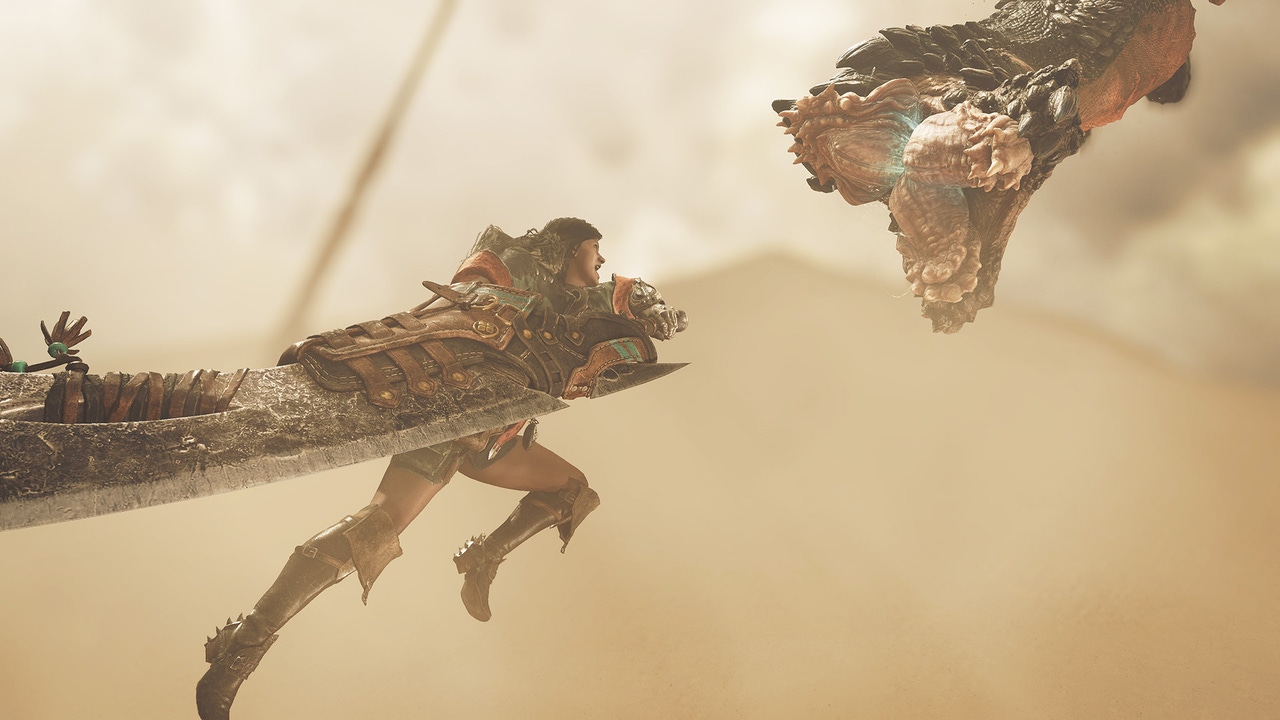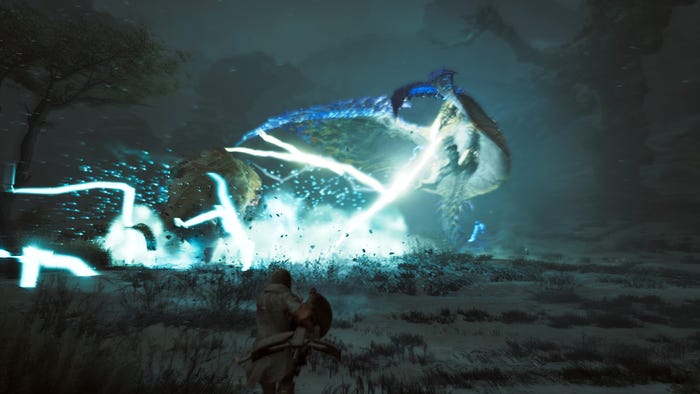Trending
Opinion: How will Project 2025 impact game developers?
The Heritage Foundation's manifesto for the possible next administration could do great harm to many, including large portions of the game development community.
The key creatives behind Capcom's series explain why their next game had to go even bigger.

The Monster Hunter series has been steadily building toward players and the large-scale battles they undertake into a more open world experience. With recent entries leaning into the scope of its setting, Capcom's daunting and equally thrilling monster-slaying action game has grown since finding its way back to consoles after years on handhelds, and the next game is bringing about the most significant changes the series has seen yet.
Following the breakthrough success of Monster Hunter World, which brought an even larger audience to the series, Capcom aims to have Monster Hunter Wilds shake up the established structure and flow for the series' first open world game. This intended shake-up hinges on bringing the series' epic battles into a more dynamic and interconnected world that's rife with emergent encounters against large-scale creatures and a more hostile ecosystem that evolves in real time.
At Summer Game Fest 2024, we saw an extended demo of Monster Hunter Wilds and spoke with series producer Ryozo Tsujimoto, executive director and art director Kaname Fujioka, and game director Yuya Tokuda about how the next game puts its new open world in the spotlight, and how the massive success of the series has led them to rethink Monster Hunter for a global audience.
Since its debut in 2003, the Monster Hunter series has focused on a timed mission-based structure that led players into excursions through connected zones to hunt key targets. This fragmented, excursion-style approach is what the series has been built on, but following the success of Monster Hunter World and its experimentation with a larger sandbox and more narrative worldbuilding—which now stands as Capcom's best-selling game—the shift to a more seamless and dynamic Monster Hunter game was something that executive director and art director Kaname Fujioka felt was vital for Wilds.
"The seamlessness of the game is really one of our core efforts in designing Monster Hunter Wilds, and ever since World, we've always wanted to design the ecosystems and the environments more detailed and immersively," said Fujioka. "That aspect necessitates the kind of seamlessness of the world where we can have all these concepts running together, all within an environment that feels threatening and filled with hostile monsters that you can freely hunt."

Image via Capcom.
Much like previous Monster Hunter games, Wilds sees players take on the role of hunters contending with an unexplored locale that's teeming with new wildlife to battle and resources to collect.
Though Wilds absolutely retains this conceit, the private demo shown at Summer Game Fest presented a detailed look at an average session in the game, which showed the new systems that actively ditch some of the series' more steadfast and hardened rules as it moves the series to a more seamless and organic world.
There's a clear focus on giving players a more freeform approach to being a hunter of large monsters, allowing for more room to comfortably explore the setting and choose targets without a timer. Instead of starting in the town hub to gain new quests, restock on items, change load-outs, and squad up before going on an instanced expedition, Wilds now brings a more modern open world experience akin to Horizon Zero Dawn or Ghost of Tsushima, wherein towns, activities, and hunts are within the world and engaged without any loading screens.
In the demo, the hunter moved from a desert settlement filled with merchants and other explorers into the large biome on their mount. The hunters can now observe and track monsters, including the new herds of roaming monsters in each biome and new plant life and resources to collect with. Along with more monsters and critters, there are also NPC hunters who can join you if you need assistance. After completing a hunt, the player can keep exploring to try another hunt or retreat to town or an improvised camp in the field to cook food and recover.
A clear focus with Wilds is that the developers are more focused on keeping players in the world, instead of being ferried back to safety to start a new mission. By moving Monster Hunter away from the established excursion structure, and into a more explorable and evolving world, the developers want players to be more active in contending with the myriad of systems at work.
"We also focused a lot on the type of interactions you can find when exploring, like with packs of monsters, chasing down hurt targets, and how they conflict with other human hunters," said the executive director. "We also have these characters with 24-hour patterns of behavior that are much more involved than in previous titles. These details all show not only how seamless and organic the world is, but also how dynamic it feels."
The other significant innovation in Monster Hunter Wilds is the new evolving ecosystem, which sees real-time shifts to the weather and monster population. During the demo, we saw a sandstorm occur during a hunt. Conditions got worse when a violent lightning storm kicked in, which made the environment even more hostile. While the devs were chasing the target on their mount, we saw monsters in the areas scurrying to safety to avoid the weather hazards, which heightened the need to complete the hunt quickly. The terrain also became unstable, with one area turning into a massive sand pit that sucked in some minor monsters. This level of emergent, environmental gameplay, somewhat in the vein of The Legend of Zelda: Breath of the Wild, is something that the series has toyed with, but now it looks to be far more ingrained in the flow of Wilds' core gameplay.
That dynamic aspect of the world actively becoming hostile towards you, yet still teeming with activity to appreciate, was something that game director Yuya Tokuda wanted for the series. Still, it hasn't been possible till now, thanks to new technology.
"One of the biggest things that we've been able to challenge ourselves with in Wilds is building out a massive, changing ecosystem that not only incorporates more monsters but other characters within the world that also interact with those monsters," said Tokuda. "Along with those heightened interactions, these different environmental changes are happening simultaneously. That's something that the technology we have now has made possible, which we couldn't do before, and I think we did a good job bringing that all together."

Image via Capcom.
While Monster Hunter games have been about the experience of being a hunter, Wilds, and its focus on having players contend with the environment while keeping their targets in sight, heightens that by adding somewhat of a survivalist twist. With players having to compete in an open world with an evolving ecosystem and more active shifting of flora and fauna, the hunters in the game will have to be more adaptable to change— which includes building camps (that can be destroyed by monsters) and using new gadgets like camouflage to stay in hiding. Coupled with a more fleshed-out and structured world to explore, it's an intriguing and sensible shift for the series that really ups the hunter experience that the series excels at.
For series producer Ryozo Tsujimoto, the success of Monster Hunter World offered some important lessons for Capcom—not only in terms of building up the next Monster Hunter game but also for making a new game that feels modern and in tune with the series' global audience.
"From the get-go, we approached Monster Hunter World with a global mindset," said Tsujimoto. "At that point, we had approached things by releasing in Japan first and following up with other territories, but World was our first worldwide simultaneous release for Monster Hunter. It was also the first game we made with so many forms of localization."
"That seems obvious to say, but that was a challenge for us initially because, with that global approach, we had to open up the series to other Capcom members across the globe to give opinions and input on the kind of direction the series would be going on," he continued. "That was a great challenge and lesson for us, but another thing we learned and wanted to focus on more with Wilds was taking greater consideration and care for players who haven't played Monster Hunter in a long time and how we can kind of get them back in the saddle."
Given how the series had steadily grown and built up a large audience to become one of Capcom's key franchises, seeing Monster Hunter embrace a more open world experience, leaning further into the epic scale of the battles and environments, is exciting. It also showcases the immense growth that Capcom has had in the last decade with its focus on reinvesting in its core franchises—much like Resident Evil, the Monster Hunter series is also going through its own transformation.
By moving away from its modest and old-fashioned structure to a more open-ended game, Wilds showcases just how weird and wondrous the Monster Hunter universe has always been. It looks to be the series' first true effort for players to really get to know its setting on a moment-to-moment scale—and that's a great change for the series.
You May Also Like